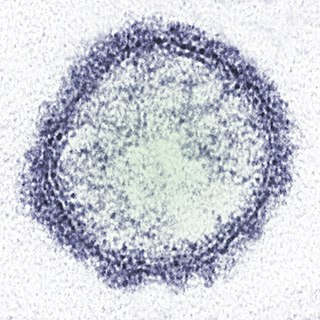Bwamba orthobunyavirus (BWAV) belongs to the genus Orthobunyavirus and the order Bunyavirales RNA viruses. BWAV is present in large parts of Africa, endemic in Mozambique, Tanzania and Uganda. It is transmitted to humans through mosquito bites and results in a brief benign generalised infection with headache, skin rash, diarrhea and joint pain and lasts 4–5 days. The animal reservoir of the virus includes birds, monkeys and donkeys.

Oropouche fever is a tropical viral infection transmitted by biting midges and mosquitoes from the blood of sloths to humans. This disease is named after the region where it was first discovered and isolated at the Trinidad Regional Virus Laboratory in 1955 by the Oropouche River in Trinidad and Tobago. Oropouche fever is caused by a specific arbovirus, the Oropouche virus (OROV), of the Bunyaviridae family.
California encephalitis orthobunyavirus type strain California encephalitis virus was discovered in Kern County, California and causes encephalitis in humans. Encephalitis is an acute inflammation of the brain that can cause minor symptoms, such as headaches, to more severe symptoms such as seizures. Mosquitoes serve as its carrier and for this reason this virus is known as an arbovirus.
Oropouche orthobunyavirus (OROV) is one of the most common orthobunyaviruses. When OROV infects humans, it causes a rapid fever illness called Oropouche fever. OROV was originally reported in Trinidad and Tobago in 1955 from the blood sample of a fever patient and from a pool of Coquillettidia venezuelensis mosquitoes. In 1960, OROV was isolated from a sloth and a pool of Ochlerotatus serratus mosquitoes in Brazil. The virus is considered a public health threat in tropical and subtropical areas of Central and South America, with over half million infected people as of 2005. OROV is considered to be an arbovirus due to the method of transmission by the mosquitoes Aedes serratus and Culex quinquefasciatus among sloths, marsupials, primates, and birds.

Orthobunyavirus is a genus of the Peribunyaviridae family in the order Bunyavirales. There are currently ~170 viruses recognised in this genus. These have been assembled into 97 species and 20 serogroups.

Akabane orthobunyavirus is an insect-transmitted virus that causes congenital abnormalities of the central nervous systems in ruminants. The virus is found in Australia, where it is most commonly spread by biting midges of the Culicoides species.
Bunyamwera orthobunyavirus (BUNV) is a negative-sense, single-stranded enveloped RNA virus. It is the type species of the Orthobunyavirus genus, in the Bunyavirales order.

Schmallenberg orthobunyavirus, also called Schmallenberg virus, abbreviated SBV, is a virus that causes congenital malformations and stillbirths in cattle, sheep, goats, and possibly alpaca. It appears to be transmitted by midges, which are likely to have been most active in causing the infection in the northern hemisphere summer and autumn of 2011, with animals subsequently giving birth from late 2011. Schmallenberg virus falls in the Simbu serogroup of orthobunyaviruses. It is considered to be most closely related to the Sathuperi and Douglas viruses.
Tete orthobunyavirus is a bunyavirus found originally in Tete Province, Mozambique. It is a disease of animals and humans. Two forms, Bahig and Matruh viruses, were isolated from bird ticks including Hyalomma marginatum, but elsewhere mosquitoes and biting midges have been implicated as vectors.

Emaravirus is a genus of plant viruses and the sole genus in the family Fimoviridae. The genus has 11 species. The type species European mountain ash ringspot-associated emaravirus is associated with a leaf mottling and ringspot disease of European mountain ash Sorbus aucuparia. It can be transmitted by grafting and possibly mites.
The 63U-11 virus (63UV) is a strain of Marituba virus in the genus Orthobunyavirus.
The 75V-2621 virus is a strain of Gamboa virus in the genus Bunyavirus. It was first isolated in the mosquito Aedeomyia squamipennis in Vinces, Ecuador in 1974. Ad. squamipennis appears to be the vector and birds a host, including the chicken Gallus gallus domesticus under experimental conditions. It has only been isolated in the tropical regions of Central and South America. It has not be shown to cause disease in humans, or domestic and wild animals; however, in a 2018 study, antibodies against the Gamboa virus were found in birds (6.2%), humans (1.5%), and other wild animals (2.6%).
Acara orthobunyavirus (ACAV) is a species in the genus Orthobunyavirus, belonging to the Capim serogroup. It is isolated from sentinel mice, Culex species, and the rodent Nectomys squamipes in Pará, Brazil and in Panama. The symptoms of the Acará virus is death. Sometimes reported to cause disease in humans.
Anhembi orthobunyavirus, formerly simply Anhembi virus (AMBV), is a species of virus. It was initially considered a strain of Wyeomyia virus, belonging serologically to the Bunyamwera serogroup of bunyaviruses. In 2018 it was made its own species. It was isolated from the rodent - Proechimys iheringi - and a mosquito - Phoniomyia pilicauda - in São Paulo, Brazil.
Tahyna orthobunyavirus ("TAHV") is a viral pathogen of humans classified in the California encephalitis virus (CEV) serogroup of the Orthobunyavirus family in the order Bunyavirales, which is endemic to Europe, Asia, Africa and possibly China.
Batai orthobunyavirus (BATV) is a RNA virus belonging to order Bunyavirales, genus Orthobunyavirus.
Jamestown Canyon encephalitis is an infectious disease caused by the Jamestown Canyon virus, an orthobunyavirus of the California serogroup. It is mainly spread during the summer by different mosquito species in the United States and Canada.
Tensaw orthobunyavirus is a virus in the genus Orthobunyavirus of the Bunyamwera arbovirus group, order Bunyavirales. It is named for the river bordering the area in south Alabama where the prototype strain was discovered. It is abbreviated TEN, TENV, and TSV in the scientific literature.

Peribunyaviridae is a family of viruses in the order Bunyavirales. Its name partially derives from Bunyamwera, Uganda, where the founding species was first isolated.




